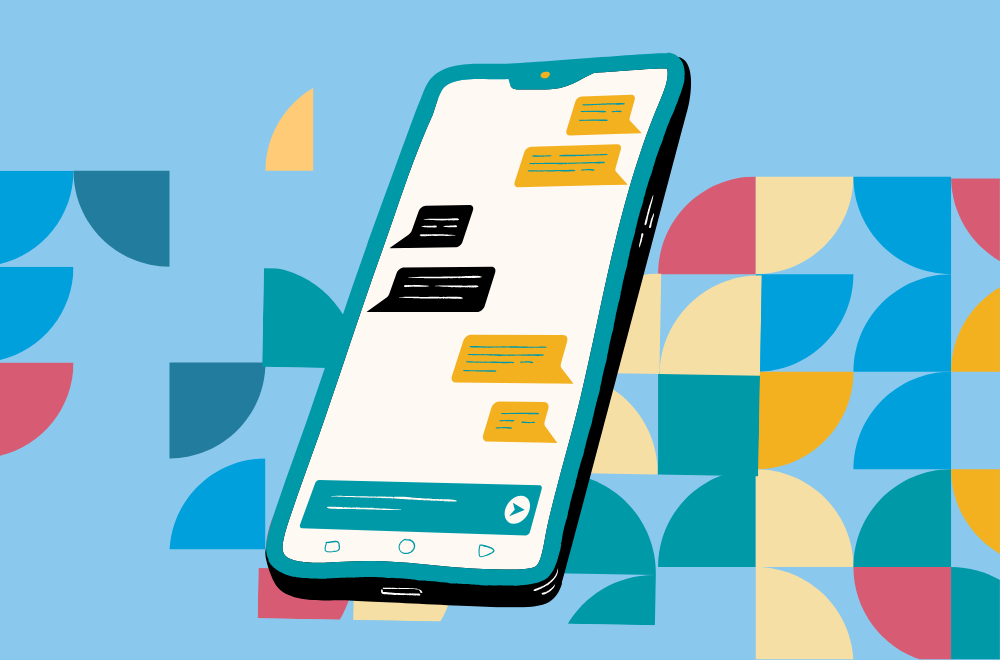Using WhatsApp Business in Global Health Programs

WhatsApp Business may help programs communicate with users at scale, through a popular app that creates a seamless knowledge management (KM) experience in their daily lives.
Social media platforms can support knowledge access, sharing, learning, and exchange—but with the explosion of options, sophistication of content algorithms, and variability in content moderation approaches, these platforms can also work against KM and learning goals.
WhatsApp Messenger is the most popular messaging app globally (based on monthly active users) and has been incorporated into global health programming for years, largely as a tool for data collection, communication, and continued professional development. WhatsApp’s Application Programming Interface (API) can power chatbots and there are numerous examples of its use in the family planning and reproductive health space. Breakthrough ACTION’s DSSR-bot, Ask Nivi, UNFPA’s JustAsk, and MOMENTUM’s Tata Annie and VIYA are just a few.
But what about WhatsApp Business, its companion product?
Our Knowledge SUCCESS marketing team applies business-centric tools like geotargeting, automation, and AI-driven personalization to generate and meet demand for knowledge. We reach more than 170,000 users annually through this website alone, where we’ve increased the proportion of users from low and middle-income countries to 70 percent (from 41 percent when we started). We use a customer journey mindset to drive our efforts. This means putting user satisfaction at the forefront of our product development and marketing, providing the best possible experience, and actively listening to feedback.
On the Knowledge SUCCESS project, we are constantly testing new approaches that blend business strategy with best practices in health communication. Many small businesses use WhatsApp Business to communicate with customers. Recently, I explored what it could look like if global health programs followed the same path.
What is WhatsApp Business?
WhatsApp Business is entirely separate from WhatsApp Messenger (the version of WhatsApp that the vast majority of individuals use). It is a free app, designed for small businesses to communicate with their customers.
Once businesses create a WhatsApp Business account, they’re able to design a “virtual storefront” that includes:
- Basic information such as a logo, business description, hours of operation, and website.
- Automated greeting messages for customers who initiate a conversation with the business.
- Customizable message templates that are text-based, media-based, or interactive and can send files of up to 100MB.
- Quick replies, a feature that allows businesses to save answers to commonly asked questions as templates and set up shortcuts to respond to queries more quickly.
- A product catalog displayed on their business profile. Each product or service can include an image, title, price, description, product code, and link to the product on a website. Businesses are allowed a maximum of 500 products or services.
Using WhatsApp Business to support a “customer journey” mindset
Think about this in the context of global health programs and a customer journey mindset. Imagine users navigating to a WhatsApp “storefront” for your program, where a product catalog could serve as an alternative interface to a program website or repository for materials. Hosting PDF versions of resources on a free or low-cost cloud drive (such as Google), you could list them in a searchable product catalog. It is possible to create collections within a catalog so resources can be grouped together by theme. The Cart feature could be adapted to allow users to go through an e-commerce process (or “sales funnel”), where they would “add” resources to a cart, proceed to checkout, provide an email address, and the contents of their cart would be sent to them to access at a later time– that feature could be especially beneficial for users who live in remote or low-bandwidth settings.
What is WhatsApp cloud-based API?
For medium and large companies that receive a high volume of messages per day, WhatsApp Business introduced a cloud-based API that can be used to manage customer messages at scale and automate tasks.
Scale is the major appeal of this paid option, which can handle automated communications with thousands of contacts. Once they have secured a customer’s permission (via opt-in) to contact them, businesses can send them text-based, media-based, or interactive messages on WhatsApp.
The API platform does not have a user interface for non-developers, which has cost implications and makes it more challenging to manage and interact with. Businesses have to build an interface themselves or contract with a developer to build one. The platform operates on conversation-based pricing. The first thousand conversations each month are free; after that, businesses are charged for each 24-hour conversation. Calculating expected costs can be challenging because conversation rates differ depending on the market (that is, the country) and currency. Note that all WhatsApp Business accounts (both free and API versions) are tied to a valid mobile phone number, so businesses must pay for a monthly or annual mobile plan cost.
Using WhatsApp API for personalized learning and capacity strengthening
Because the WhatsApp Business cloud-based API is set up as a customer support platform, it lends itself well to personalization and localization. There is tremendous potential to adapt its chatbot model for learning and capacity strengthening. For example, a closed-loop AI or decision-tree-based chatbot, which uses logic programming and a closed data set on which it bases its responses, can be trained to answer basic questions, suggest resources, and even recommend relevant programmatic approaches for an individual’s specified challenge using pre-written responses. Note that using a closed data set, selected and reviewed by trained technical staff, is vital to control quality of responses.
Logic programming opens possibilities for localization and contextualization— as the chatbot identifies different dialogue paths based on the user’s age, gender, preferred language, geographic location, job role or title, and topic of interest. We have seen firsthand how contextualization, an award-winning component of our marketing work, can result in greater user engagement and satisfaction rates. A chatbot-based capacity strengthening approach could supplement popular, more traditional approaches at scale, for a portion of the cost.
Moving from theory to application in an evolving product landscape
For now, the ideas in this blog post are theoretical. In the future, WhatsApp Business may appeal to programs who want to communicate with users at scale, through a popular messaging app that creates a seamless experience in their daily lives. More than three billion people already use WhatsApp. Global health workers are not only primed to see WhatsApp as a successful platform for digital interventions from their own work, but many also use it for communicating in their personal lives and may therefore be more receptive to engaging with it in their professional capacities.
It remains to be seen how the built-in AI within Meta products may change knowledge exchange and information-seeking behaviors. WhatsApp (owned by Meta) recently debuted a feature that allows users to search the Internet directly through the messaging app. It is too soon to tell if WhatsApp users will embrace the ability to do so, making the app even more relevant to KM approaches as individuals begin to have both conversations and searches within one app interface, or if users will reject the integration as an unwelcome intrusion within a “personal” digital space. Stay tuned for future insights on how digital platforms, including WhatsApp, evolve their generative AI integration and what these evolutions mean for digital KM approaches.




